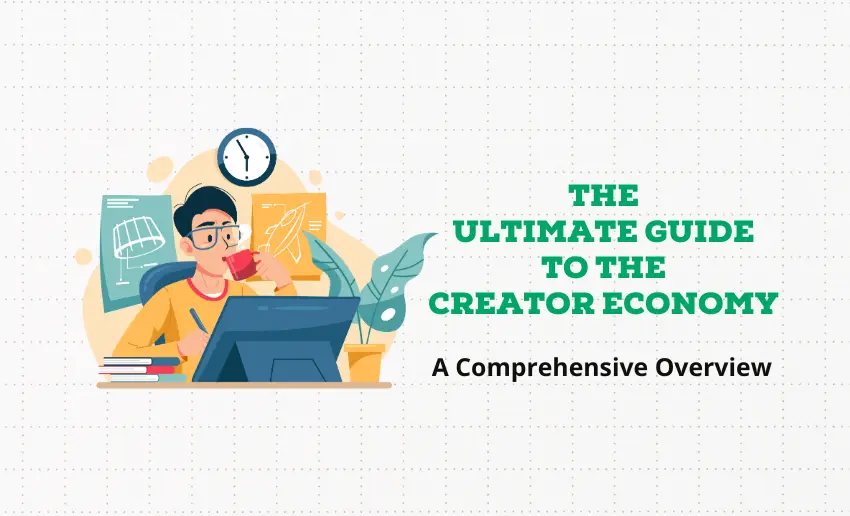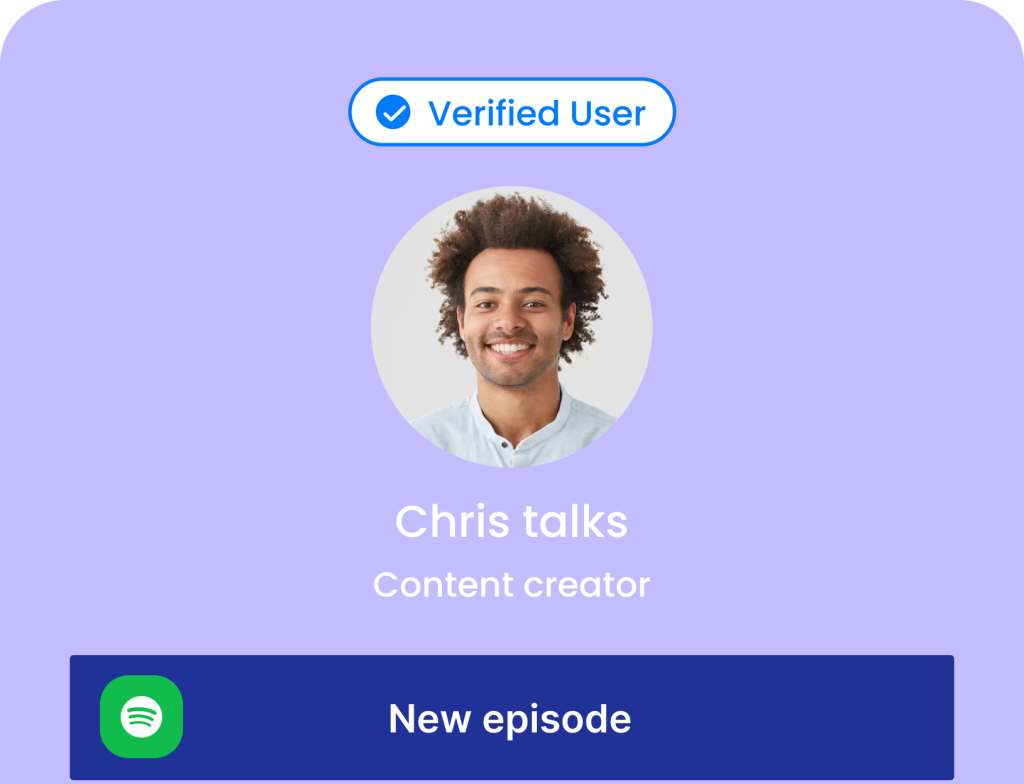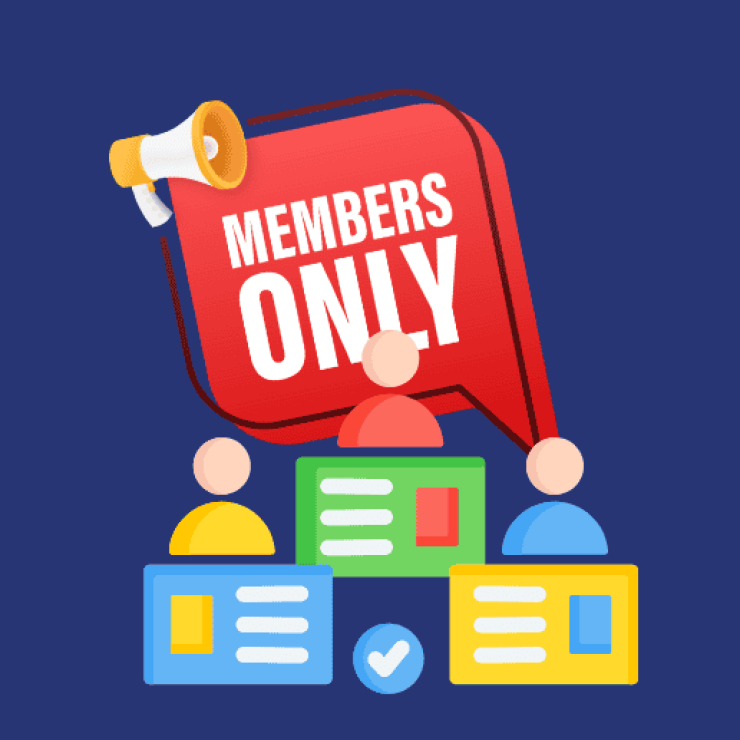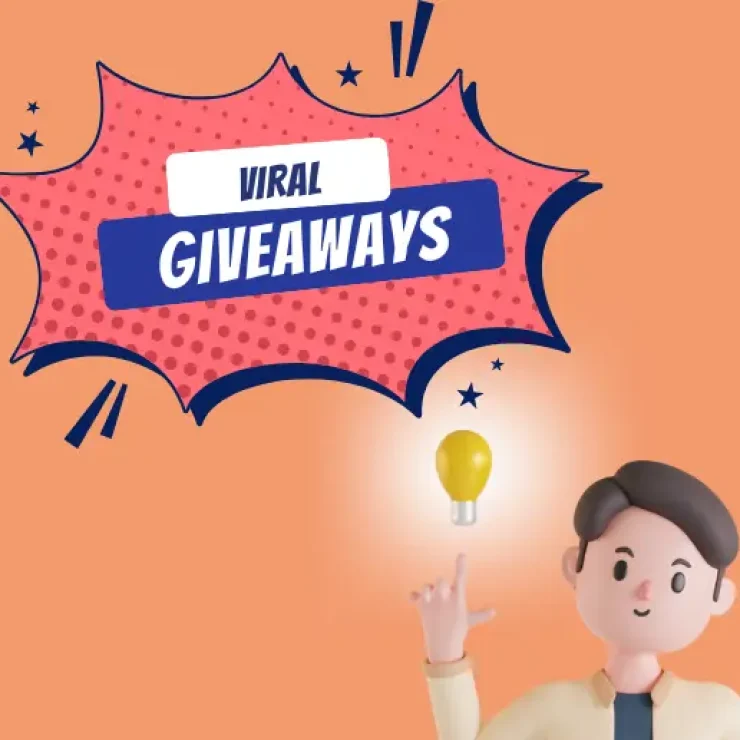In the last twenty years or so, a seismic shift has transformed the way individuals create, share, and monetize content online. The rise of the creator economy has not only opened up entrepreneurship but also redefined traditional notions of work and success. From social media influencers to independent artists, creators across various platforms are harnessing their skills and passions to build thriving online communities and sustainable revenue streams.
Aspiring creators looking to turn their passion into a profession or business professionals seeking to understand this rapidly evolving landscape need to learn more about this emerging economy. In this comprehensive guide, we explain the Creator Economy in detail, exploring its key components, monetization strategies, the platforms that empower them, challenges, and trends.
The ultimate guide to the creator economy
The Creator economy refers to a digital ecosystem where individuals leverage their skills, talents, and expertise to create and distribute content online. This often involves generating revenue directly from their audience or through partnerships with brands and platforms. The creator economy has emerged as a result of technological advancements, especially in social media and digital content platforms.
Side hustles in the Creator economy
There are loads of opportunities to make money from side hustles in the Creator economy. Many creators often rely on these means to monetize their content.
Some of the most popular side hustles include:
1. Digital product creation
Creating and selling digital products is a popular side hustle in the creator economy. These include ebooks, online courses, templates, digital art, and software tools. Creators can leverage their expertise and skills to develop valuable digital assets that cater to specific niches or solve problems for their audience.
2. Freelancing services
Many creators offer freelance services related to their niche, such as writing, graphic design, video editing, social media management, or consulting. Freelancing allows creators to utilize their talents on a project basis, working with clients and businesses to meet their specific needs. Platforms like Upwork, Fiverr, and Freelancer.com connect freelancers with potential clients, providing opportunities to earn additional income and expand their professional network in the creator economy.
3. Affiliate marketing
Creators can partner with affiliate programs related to their niche or interests, recommending products they genuinely believe to their audience. Popular affiliate platforms like Amazon Associates, ShareASale, and CJ Affiliate offer a wide range of products and brands for creators to promote, allowing them to monetize their influence and recommendations in the creator economy.
4. Sponsored content
Collaborating with brands and businesses for sponsored content is another lucrative side hustle for creators. Brands pay creators to promote their products or services through sponsored posts, videos, or live streams, effectively reaching their target audience.
5. Print-on-demand merchandise
Print-on-demand (POD) services enable creators to design and sell custom merchandise like apparel, accessories, home decor, and more without the need for inventory or upfront costs. Platforms like Teespring and Redbubble handle printing, shipping, and customer service, allowing creators to focus on designing and marketing their merchandise.
6. Subscription services
Launching subscription-based services or memberships is a popular strategy for creators to generate recurring revenue and cultivate a loyal community of supporters. Creators can offer exclusive content, perks, and access to members-only events or communities in exchange for a monthly or annual subscription fee. Platforms like Patreon, Substack, and OnlyFans provide tools for creators to create and manage subscription tiers.
7. Crowdfunding and donations
Crowdfunding platforms like Kickstarter, Indiegogo, and GoFundMe allow creators to raise funds for creative projects, products, or charitable causes through donations or pledges from their audience. Creators can launch crowdfunding campaigns to finance new ventures, support passion projects, or give back to their community.
8. Licensing and royalties
Creators can license their content, intellectual property, or creative work to third parties for use in various projects, products, or media formats, earning royalties or licensing fees in return. Licensing opportunities may include:
-
Selling music tracks to filmmakers.
-
Licensing artwork for merchandise or publications.
-
Granting usage rights for photos or videos to businesses and advertisers.
Creator Jobs in the Digital Era
As the Creator economy continues to boom, job opportunities continue to increase. Big brands and businesses are always in search of seasoned creators to help them tap into the digital space.
1. Social media Influencer
In the creator economy, a social media influencer is someone who uses platforms like Instagram, TikTok, or YouTube to share content and promote products or services to their followers.
These influencers often collaborate with brands for sponsored content or endorsements, earning income through partnerships and affiliate marketing. They build a loyal audience by creating engaging and relatable content that resonates with their followers’ interests and preferences, leveraging the power of social media to become influential figures within their niche.
2. YouTuber
A YouTuber is a creator who produces videos on YouTube, covering a wide range of topics from entertainment and education to lifestyle and gaming. They monetize their channels through ad revenue, sponsorships, and selling merchandise or digital products.
YouTubers engage with their audience through comments, live streams, and community features, fostering a sense of community and loyalty among their subscribers. Successful YouTubers understand the platform’s algorithm and trends, optimizing their content to reach a wider audience and grow their channel.
3. Podcast host
A podcast host creates audio content on various topics, from interviews and storytelling to news and discussions. They monetize their podcasts through sponsorships, advertising, and listener support platforms like Patreon.
Podcast hosts focus on creating compelling and informative episodes that resonate with their audience, building a loyal listener base over time. They often collaborate with guests and other creators to diversify content and reach new audiences, leveraging the growing popularity of podcasts in the digital era.
4. Freelance writer/blogger
A freelance writer or blogger creates written content for websites, blogs, and online publications. They monetize their work through freelance gigs, sponsored content, and affiliate marketing.
Freelance writers and bloggers focus on producing high-quality and engaging articles that attract readers and drive traffic to their platforms. They often specialize in specific niches or topics, positioning themselves as experts in their field and attracting clients and opportunities in the competitive creator economy.
5. Online educator/coach
An online educator or coach in the creator economy creates educational content and courses on topics like fitness, nutrition, business, languages, and personal development. They monetize their expertise through course sales, memberships, and coaching services.
Online educators and coaches leverage platforms like Teachable, Udemy, or Patreon to reach students and clients worldwide, offering valuable knowledge and guidance in the creator economy. They focus on delivering actionable content and personalized support to help their audience achieve their goals and aspirations.
6. Twitch streamer
Twitch streamers create live streaming content on the Twitch platform, covering gaming, entertainment, creative arts, and more. They monetize their streams through subscriptions, donations, sponsorships, and merchandise sales.
Twitch streamers engage with their audience in real time, building a dedicated community of viewers and supporters. They often collaborate with other streamers, participate in gaming events, and leverage Twitch’s features like emotes and channel points to enhance the viewer experience and grow their channel in the competitive creator economy.
7. Online entertainer/comedian
An online entertainer or comedian creates entertaining and comedic content on platforms like TikTok, Instagram Reels, or Twitter. They monetize their humor through brand partnerships, sponsored content, and merchandise sales.
Online entertainers and comedians leverage trends, memes, and viral challenges to engage with their audience and gain visibility in the crowded digital space. They focus on creating shareable and relatable content that resonates with their followers, often collaborating with other creators to amplify their reach and impact.
8. Gaming content creator
Gaming content creators produce gaming-related content such as gameplay videos, reviews, tutorials, and live streams on platforms like YouTube, or Twitch. They monetize their gaming content through ad revenue, sponsorships, donations, and merchandise sales.
Gaming content creators engage with their audience through interactive streams, gaming communities, and esports events, building a dedicated fanbase and establishing themselves as influencers in the gaming industry. They stay updated on new games, trends, and gaming technology, creating content that entertains, educates, and inspires gamers worldwide.
9. Virtual reality (VR) creator
A virtual reality (VR) creator produces immersive and interactive experiences using VR technology, creating content for gaming, entertainment, education, training, and simulations. They monetize their VR content through app sales, subscriptions, virtual events, and partnerships with VR platforms and developers.
VR content creators explore innovative storytelling techniques, interactive gameplay, and realistic simulations to engage users and push the boundaries of virtual reality in the creator economy. They collaborate with VR designers, developers, and tech enthusiasts to create compelling and memorable VR experiences that captivate audiences and drive the adoption of VR technology worldwide.
Creator marketing stats and insights
Creator marketing has become a cornerstone of digital advertising strategies. Today, brands are increasingly leveraging influencers and content creators to reach and engage audiences.
Here are some key stats and insights shaping the creator marketing landscape:
-
The influencer marketing industry witnessed a staggering growth of over 550% between 2016 and 2020.
-
U.S. brands are projected to invest a substantial $7.14 billion in influencer marketing in 2024, as per Sprout Social.
-
Recent data from Forrester indicates that 71% of U.S. consumers prioritize authentic brands and actively support them.
-
The creator economy encompasses a wide array of sectors, including cooking, fashion, fitness, technology, finance, and entrepreneurship.
-
The services sector within the creator economy is anticipated to experience a robust growth of over 17% from 2021 to 2025.
-
A significant number of creators expressed feeling negatively impacted by algorithm changes.
-
The affiliate market is on a steady growth path, with an annual growth rate of 10%, projected to reach a substantial $40 billion by 2030.
-
Full-time creators predominantly focus on creating social media posts, emails/newsletters, and articles/blogs.
-
Globally, there are an estimated 200 million content creators, according to Linktree.
-
Educational creators, bloggers, coaches, writers, and artists emerge as the most prevalent types of creators in the digital landscape.
-
The majority of content creators cite brand deals as their primary source of revenue.
-
Forbes identifies prominent figures like Mr. Beast, Charlie D’Amelio, Alexandra Cooper, Elliot Table, Emma Chamberlain, and Huda Kattan as the leading content creators in the creator economy.
-
On average, content creators take approximately six and a half months to earn their first dollar.
Creator economy major trends for 2024
Several trends have shaped the creator economy in the past. As it continues to boom, different trends are sure to emerge. In 2024, the Creator economy is expected to see a sharp rise, with an upward surge in the number of trends expected to shape its future.
Below are some of the top trends shaping the Creator economy landscape:
1. NFTs and Blockchain technology
NFTs (Non-Fungible Tokens) and blockchain technology are revolutionizing the creator economy by offering new ways to monetize digital assets and authenticate ownership. NFTs allow creators to tokenize their digital content, such as artwork, music, videos, and collectibles, turning them into unique and tradable assets on blockchain platforms.
Blockchain technology ensures transparency, security, and immutability, providing a decentralized and tamper-proof system for verifying ownership and provenance of digital assets. Creators can leverage NFTs to create limited editions, offer exclusive content, and engage with a global audience of collectors and enthusiasts.
2. UGC creators: A shift towards Industry experts
In the creator economy, user-generated content (UGC) creators are transitioning from mere hobbyists to professional content creators. This shift is driven by the increasing demand for authentic and relatable content among audiences.
UGC creators, who were once seen as amateurs creating content for fun or personal expression, are now recognized for their ability to connect with audiences. They often bring a unique perspective and storytelling style that resonates with viewers, leading to higher engagement and loyalty.
As UGC creators evolve into professionals, they are honing their skills, refining their content strategies, and investing in quality production tools. Many are building personal brands, collaborating with brands and businesses, and monetizing their content through various channels such as sponsorships, ads, and merchandise sales.
3. Evolving audience preferences
The evolving preferences of audiences are also shaping the creator economy, influencing content trends, consumption habits, and engagement strategies. Creators are adapting by focusing on storytelling, community building, and personalized experiences to connect with their audience on a deeper level.
Evolving audience preferences also encompass diversity, inclusivity, and social impact, driving creators to embrace diversity in content representation, advocate for social causes, and engage with diverse communities. Creators are exploring niche markets, micro-communities, and hyper-personalized content to cater to specific audience segments and enhance engagement.
4. Prioritizing genuine content over highly edited material
In 2024, the emphasis on authenticity over polished content continues to grow in the creator economy. Audiences are drawn to creators who are genuine, transparent, and relatable, even if their content isn’t perfectly polished.
This shift reflects a desire for real connections and experiences rather than overly curated and staged content. Creators who embrace authenticity showcase their personality, quirks, and imperfections, fostering trust and authenticity with their audience.
As brands and creators prioritize authenticity, they focus on storytelling, real-life experiences, behind-the-scenes glimpses, and genuine interactions. This approach humanizes the content, making it more relatable and engaging for viewers.
5. Creators leading the way in campaigns
This trend involves brands collaborating directly with content creators to develop and execute marketing campaigns. Creators bring their authentic voice, creativity, and audience insights to these campaigns, resulting in more engaging and relatable content. Brands leverage the influence and reach of creators to connect with their target audience genuinely.
Creator-led campaigns also enable brands to access niche audiences and diverse content formats that resonate with specific demographics. Creators have a deep understanding of their audience’s preferences, behaviors, and interests, making them valuable partners for brands seeking to create impactful campaigns.
As this trend continues to grow, we can expect to see more brands invest in long-term partnerships with creators, incorporate influencer marketing strategies into their overall marketing plans, and embrace the power of authentic storytelling in the digital landscape.
6. Businesses shifting content creation internally
Another major trend shaping the creator economy in 2024 is brands bringing content creation in-house. Rather than relying solely on external agencies or freelancers, many brands are building internal teams dedicated to content creation and influencer marketing.
This shift allows brands to have more control over their content strategy, creative direction, and brand messaging. When harnessing the expertise and creativity of in-house teams, brands can produce high-quality content consistently and respond quickly to market trends and audience feedback.
Also, bringing content creation in-house provides brands with cost savings, flexibility, and the ability to build deeper relationships with creators and influencers. Brands can collaborate closely with creators, aligning content with their brand values, goals, and target audience preferences. This trend highlights the growing importance of content creation as a strategic priority for brands in the digital age.
Creator economy channels/platforms
Platforms in the creator economy are composed of a wide range of digital spaces where creators can share content, engage with audiences, and monetize their work. These platforms differ from one another and often have distinct features. However, their goal is often to help creators make money from their content.
Types of Creator Platforms
Depending on a creator’s skill set and niche, different platforms exist for them to try out. Here are some key types of platforms:
1. Social media platforms
Social media platforms like Instagram, TikTok, YouTube, Twitter, and Facebook allow creators to reach a global audience, share content in various formats (photos, videos, text), interact with followers through likes, comments, and shares, and build a personal brand or community.
2. Content subscription platforms
Platforms like Patreon, Substack, and OnlyFans enable creators to offer subscription-based content, exclusive perks, and membership tiers to their most dedicated fans, generating recurring revenue and fostering deeper connections with supporters.
3. E-commerce platforms
E-commerce platforms such as Shopify, Etsy, and Amazon allow creators to sell physical or digital products, merchandise, artwork, and more, leveraging their audience and brand to monetize their creativity and entrepreneurial ventures.
4. Freelancing platforms
Freelancing platforms such as Upwork, Fiverr, and Freelancer.com connect creators with freelance opportunities, projects, and clients across various industries, allowing them to monetize their skills, expertise, and services.
5. Marketplaces and crowdfunding platforms
Marketplaces like Gumroad, Redbubble, and Kickstarter enable creators to sell digital products, artwork, merchandise, and crowdfund creative projects, leveraging community support and consumer demand to fund and monetize their creations.
How Platforms support creators
Platforms play a crucial role in supporting creators by providing them with tools, resources, and opportunities to thrive in the digital landscape. These channels serve as essential enablers, empowering creators to create, share, and monetize and driving innovation, entrepreneurship, and creativity.
Below is how these channels help creators:
1. Audience reach
Platforms offer creators access to a vast and diverse audience, allowing them to reach potential followers, fans, customers, and collaborators globally, regardless of geographic boundaries or physical limitations.
2. Monetization options
Platforms provide creators with various monetization options such as advertising revenue, sponsorships, memberships, subscriptions, e-commerce sales, affiliate marketing, and crowdfunding, enabling them to generate income and sustain their creative endeavors.
3. Content hosting and distribution
Platforms serve as hosting and distribution channels for creators to publish and share their content, ensuring visibility, discoverability, and accessibility for audiences across different devices and platforms.
4. Community building
Platforms facilitate community building by offering engagement features such as likes, comments, shares, direct messaging, live streams, groups, and forums, fostering interaction, collaboration, and relationship-building among creators and their audiences.
5. Analytics and insights
Platforms provide creators with analytics, data, and insights into audience demographics, engagement metrics, content performance, and trends, empowering them to make informed decisions, optimize strategies, and track progress toward their goals.
6. Creative tools and resources
Platforms offer creators access to creative tools, editing software, templates, stock media, design assets, and tutorials, enhancing their ability to produce professional-quality content, enhance their skills, and stay competitive in the digital landscape.
8 Popular creator platforms and their key features
Although numerous creator platforms share the same goal, they often differ in features. While some platforms might be similar, it’s important for a creator to understand what is available on each before deciding which to use.
These platforms offer creators diverse features and tools. Some of the most popular include:
1. Instagram
Instagram is a social media platform known for its visual content, primarily focusing on photos and short videos. Its features include:
-
Feed: The feed is where users share photos and videos with captions, engaging with followers through likes and comments.
-
Stories: Instagram Stories are temporary posts that disappear after 24 hours. They allow users to share ephemeral content like behind-the-scenes moments or daily updates.
-
Reels: Reels are short, entertaining videos set to music, similar to TikTok. They provide creators with a platform to showcase their creativity and engage with a broader audience.
2. TikTok
TikTok is a video-sharing platform known for its viral challenges, trends, and creative content. Its features include:
-
Short-form Videos: TikTok’s main feature is short-form videos, typically ranging from 15 to 60 seconds, allowing creators to showcase their talent, humor, and creativity.
-
Trending Challenges: TikTok’s algorithm surfaces trending challenges and hashtags, encouraging creators to participate and engage with the community.
-
Effects and Filters: The platform offers a wide range of effects, filters, and editing tools to enhance videos and spark creativity among creators.
3. YouTube
YouTube is a video-sharing platform focused on long-form content and monetization opportunities for creators. Its features include:
-
Video Hosting: YouTube allows creators to upload and share videos of varying lengths, from short clips to full-length movies or documentaries.
-
Live Streaming: YouTube Live enables creators to broadcast live videos, interact with viewers in real time, and host events or Q&A sessions.
-
Analytics and Insights: YouTube provides detailed analytics and insights, allowing creators to track performance, audience demographics, and engagement metrics to optimize their content strategy.
4. Twitter
Twitter is a microblogging platform known for real-time updates, news, and conversations. Its features include:
-
Tweets: Tweets are short messages limited to 280 characters that allow users to share thoughts, links, images, and videos with their followers.
-
Hashtags: Hashtags categorize tweets and facilitate discoverability, enabling users to join trending conversations or topics of interest.
-
Twitter Spaces: Twitter Spaces are audio chat rooms where users can host live conversations, discussions, or interviews with their followers.
5. Facebook
Facebook is a social networking platform with a diverse range of features for personal and professional use. Its features include:
-
Profiles and Pages: Users can create personal profiles or business pages to connect with friends, family, or customers, sharing updates, photos, and videos.
-
Groups: Facebook Groups bring together like-minded individuals to discuss topics, share resources, and build communities around common interests or goals.
-
Ads Manager: Facebook’s Ads Manager allows businesses and creators to create, manage, and optimize targeted advertising campaigns to reach specific audiences.
6. LinkedIn
LinkedIn is a professional networking platform focused on career development, networking, and business opportunities. Its features include:
-
Profiles and Resumes: LinkedIn profiles serve as digital resumes, showcasing professional experience, skills, and accomplishments to connect with employers, recruiters, and peers.
-
Connections and Recommendations: Users can connect with professionals, request recommendations, and endorse skills, enhancing credibility and networking opportunities.
-
Content Sharing: LinkedIn allows users to share articles, posts, and updates related to industry insights, career tips, and thought leadership content.
7. Pinterest
Pinterest is a visual discovery platform focused on inspiration, ideas, and creativity. Its features include:
-
Pins and Boards: Users can save and organize content (pins) into themed collections (boards), curating inspiration for recipes, home decor, fashion, and more.
-
Trending Pins: Pinterest showcases trending pins and topics, helping users discover new ideas, trends, and inspiration from a global community of creators.
-
Shop Tab: The shop tab enables users to discover and shop for products directly on Pinterest, bridging inspiration and purchase intent for brands and creators.
8. Snapchat
Snapchat is a multimedia messaging app known for its disappearing messages, AR filters, and multimedia content. Its features include:
-
Snaps: Snaps are short-lived photos or videos that disappear after being viewed, encouraging real-time, authentic sharing among users.
-
Stories: Snapchat Stories allow users to create compilations of snaps that can be viewed for 24 hours, sharing moments with friends and followers.
Creator marketing tools
Creators rely on a host of tools to help get their content in front of the right audience. From social media management platforms to graphic design tools and web analytics software, these tools simplify the work process for digital creators.
With the aid of creator marketing tools, creators can produce content quickly and monitor its impact and effectiveness.
Some of the tools creators rely on include:
1. Pushbio
Pushbio is a tool designed to solve the limitation of having only one clickable link in social media bios. It provides creators with a customizable landing page that houses multiple links, allowing them to showcase various content, products, and links in one place. This simplifies the user experience for followers who can easily navigate to different destinations from a single link. Creators can include links to their website, social media profiles, online store, blog posts, YouTube videos, and more on their Pushbio landing page.
One of the key benefits of Pushbio is its flexibility and ease of use. Creators can customize the appearance of their landing page with their brand colors, logo, and background images to create a cohesive and professional look. They can also track link clicks and performance metrics to understand which links are most popular and optimize their content strategy accordingly.
2. Google Analytics
Google Analytics is a powerful web analytics tool that provides creators with in-depth insights into website traffic, user behavior, and audience demographics. Creators can track website performance, measure conversion rates, and analyze user interactions to understand how visitors engage with their content.
Google Analytics also offers advanced features such as goal tracking, custom reports, and e-commerce tracking, empowering creators to optimize their websites, improve user experience, and drive meaningful conversions.
3. Mailchimp
Mailchimp is an email marketing platform that helps creators design, send, and analyze email campaigns to engage with their audience and nurture relationships. Creators can create personalized email newsletters, automate campaigns, and track email performance metrics such as open rates, click-through rates, and conversions.
Mailchimp’s audience segmentation and targeting features enable creators to deliver relevant content to specific audience segments, increasing email engagement and driving results.
4. SEMrush
SEMrush is an all-in-one digital marketing toolkit that provides creators with tools for SEO, content marketing, social media, and competitive analysis. Creators can use SEMrush to conduct keyword research, track rankings, audit websites for SEO issues, and analyze competitor strategies.
The platform also offers content optimization tools, social media analytics, and PPC (pay-per-click) advertising insights, helping creators improve their online visibility, drive organic traffic, and achieve marketing goals.
5. Adobe Creative Cloud
Adobe Creative Cloud is a suite of creative tools and software that includes Photoshop, Illustrator, Premiere Pro, and more. This caters to various aspects of content creation, such as graphic design, video editing, photography, and digital art.
Creators use Adobe Creative Cloud to create visually stunning graphics, edit videos, design logos, and enhance photos, showcasing their creativity and professionalism across different media formats. The platform’s collaboration features and cloud storage make it easy for creators to work on projects collaboratively and access their work from anywhere.
6. Hootsuite
Hootsuite is a social media management tool that enables creators to manage and schedule posts, monitor social media conversations, and analyze performance metrics. Creators can streamline their social media workflows, collaborate with team members, and engage with followers in real time.
Hootsuite’s social listening features allow creators to monitor brand mentions, track industry trends, and gather valuable insights to inform their content strategy and improve audience engagement.
7. Canva
Canva is a user-friendly graphic design platform that allows creators to design and customize visuals such as social media graphics, presentations, posters, and more. It offers a wide range of templates, fonts, icons, and images, making it easy for creators to create professional-looking designs without needing extensive design skills.
Canva’s drag-and-drop interface, collaboration features, and extensive library of design elements make it a valuable tool for creating engaging and visually appealing content. Plus, it’s one of the tools that creators rely heavily on.
Creator Marketing Content
Creative content such as video, visuals, live streaming, or written posts all start with the creation process. If a creator wants their content to stand out, they have to invest time and thought into the process.
While content types differ, the basis often remains the same across the board, with a few tweaks here and there. To come up with really distinct content, creators should take note of the following:
1. Understand your audience
Before creating content, it’s crucial to understand your audience’s preferences, interests, and pain points. Conduct audience research, analyze demographics, engage with followers, and gather feedback to gain insights into what resonates with them. Tailor your content to address their needs and deliver value that aligns with their expectations.
2. Define your brand identity
Clearly define your brand identity, including your values, mission, voice, and visual aesthetics. Ensure consistency across all content channels to create a cohesive brand experience. Your content should reflect your brand’s personality and messaging, reinforcing brand identity and establishing a strong connection with your audience.
3. Tell stories
Storytelling is a powerful tool for creating engaging content. Use narratives, anecdotes, and personal experiences to connect with your audience on an emotional level. Stories captivate attention, evoke emotions, and make your content memorable and relatable.
4. Provide value
Ensure that your content provides value to your audience. Whether it’s informative, educational, entertaining, or inspirational, make sure that your content addresses their pain points, answers their questions, or fulfills their needs. Valuable content keeps your audience engaged and coming back for more.
5. Use visuals effectively
Visuals such as images, videos, infographics, and graphics play a crucial role in capturing attention and conveying messages. Use high-quality visuals that are relevant to your content and enhance understanding. Visuals break up text, make content more engaging, and increase share-ability.
6. Stay authentic and transparent
Authenticity and transparency are key to building trust and credibility with your audience. Be genuine in your communication, share behind-the-scenes moments, and showcase your personality. Avoid over-promotion and focus on providing genuine value and solutions that resonate with your audience’s needs and interests.
7. Use data and feedback for optimization
Utilize data analytics, metrics, and audience feedback to continuously optimize your content strategy. Track performance metrics such as engagement rates, click-through rates, and conversion rates to understand what content performs best. Use this data to refine your content approach, experiment with new ideas, and tailor content to meet audience preferences and expectations.
Top categories in the Creator economy
The Creator economy is a vast digital space that allows a number of niches and industry experts to play. This diversification has allowed for an upsurge in the number of creators turning to it to earn a living.
That said, niches in the creator economy earn differently, and these are some of the biggest categories to look out for:
1. Social media influencers
Social media influencers create content on platforms like Instagram, TikTok, YouTube, and Twitter, collaborating with brands for sponsored content and promoting products or services to their followers.
2. Content creators and bloggers
Content creators and bloggers produce written, audio, or visual content on various topics, including lifestyle, fashion, travel, technology, and personal development. They often monetize their content through ads, sponsorships, and affiliate marketing.
3. Gaming and eSports creators
Gaming and eSports creators create gaming content, livestream gameplay, and participate in eSports tournaments. They build communities of gamers and monetize through sponsorships, donations, and merchandise sales.
4. Podcasters
Podcasters produce audio content on niche topics such as true crime, business, health, and entertainment. They engage listeners through storytelling, interviews, and discussions and monetize through ads, sponsorships, and listener support.
5. Educational and online course instructors
Educational creators and online course instructors create educational content, tutorials, and online courses on topics like business, marketing, coding, languages, and personal development, monetizing through course sales and memberships.
6. Artists and designers
Artists and designers create visual art, illustrations, graphic designs, and digital artwork, selling their creations as prints, merchandise, or digital downloads and collaborating with brands for design projects and collaborations.
7. Fitness and wellness influencers
Fitness and wellness influencers create content related to health, fitness, nutrition, and wellness, sharing workout routines, healthy recipes, and lifestyle tips and monetizing through brand partnerships and sponsored content.
8. Music creators and musicians
Music creators and musicians produce original music, covers, and music videos, promote their music on streaming platforms and social media, perform live concerts, and monetize through music sales, streaming revenue, and merchandise.
9. Tech and gadgets reviewers
Tech reviewers and gadget influencers create content reviewing and showcasing technology products, gadgets, smartphones, laptops, and consumer electronics. They share insights, recommendations, and tutorials and monetize through affiliate marketing and sponsorships.
10. Fashion and beauty influencers
Fashion and beauty influencers create content related to fashion trends, makeup tutorials, skincare routines, styling tips, and product reviews, collaborating with fashion brands, beauty companies, and retailers for sponsored content and partnerships.
In the end
The future of the Creator economy is bright and dynamic, driven by ongoing technological advancements, evolving audience preferences, and the ease of content creation and distribution. Creators will continue to play a pivotal role in shaping digital culture, influencing consumer behavior, and driving innovation across industries. The Creator economy is poised for continued growth, creativity, and disruption, empowering creative minds to thrive, connect with their audiences, and make a meaningful impact in the digital age.








